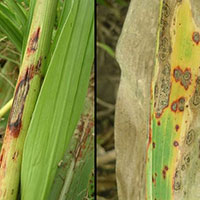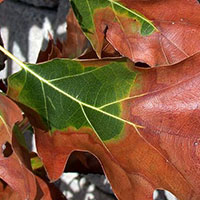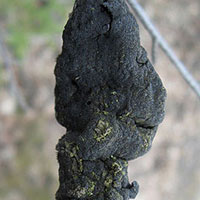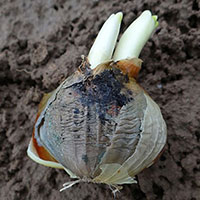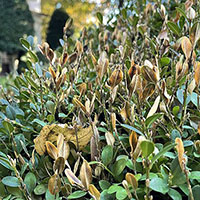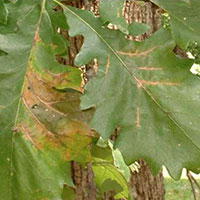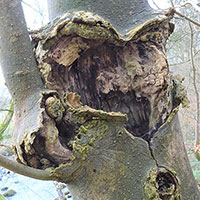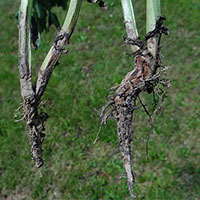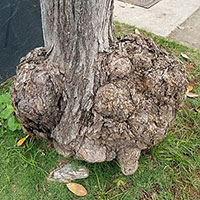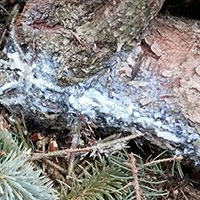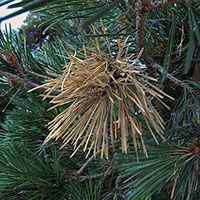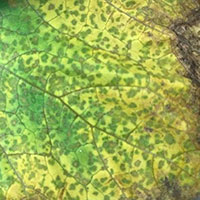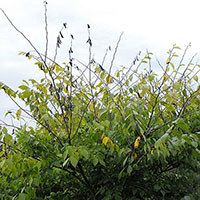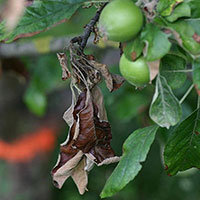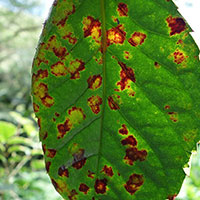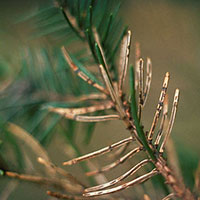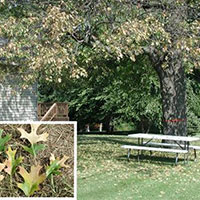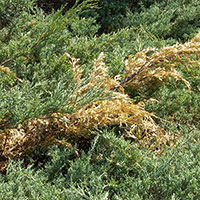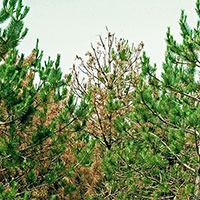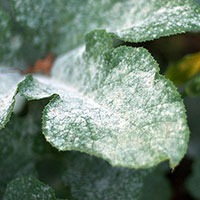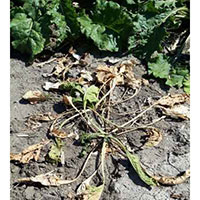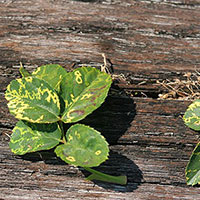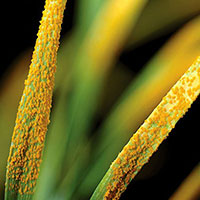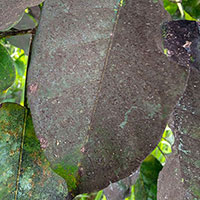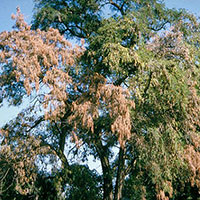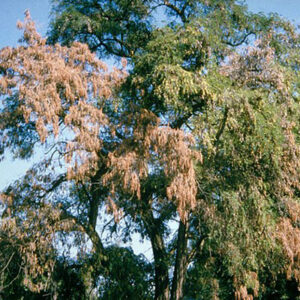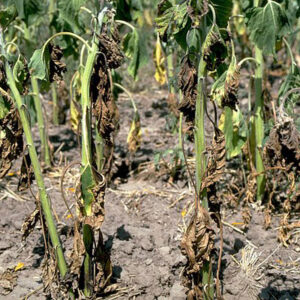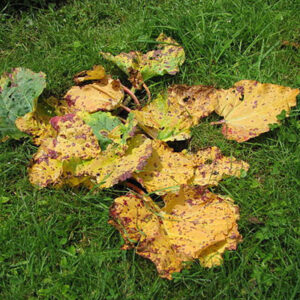How to identify and manage plant disease
Common plant disease found in northern Illinois gardens
Understanding the symptoms of plant diseases and implementing effective management strategies can help prevent and control outbreaks.
Effective management strategies for garden plant diseases include practicing good garden hygiene, such as removing diseased plant debris, avoiding overwatering, and ensuring proper pruning. Other strategies may include the use of organic or chemical pesticides, fungicides, or the planting of disease-resistant plant varieties. By being proactive in identifying and managing plant diseases, gardeners can maintain healthy and productive gardens.
For quick scrolling, click on a plant disease below…
Infectious plant disease
These diseases are caused by living organisms as opposed to abiotic (non-infectious diseases).
Fungi (F) – Fungal pathogens lack chlorophyll, which is the green pigment found in plant cells that allows plants to photosynthesize and produce their own food. Unlike plants, fungi are heterotrophic organisms, which means they cannot produce their own food and must obtain nutrients by consuming organic matter from other sources. These pathogens obtain nutrients by breaking down the organic matter of the host plant they infect.
Bacteria (B) – Bacteria are also microorganisms, but they are different from fungi in several ways, including their cellular structure and mode of nutrition. Like fungi, bacterial pathogens are heterotrophic and do not have chlorophyll. However, bacteria are prokaryotic cells, which means they lack a nucleus and other membrane-bound organelles. They also have a simpler cell wall structure compared to fungi. Bacterial pathogens can cause various plant diseases by entering the plant through natural openings or wounds and releasing toxins or other harmful substances that damage plant cells.
Viruses (V) – Unlike bacteria and fungi, viruses are not cells but rather tiny infectious particles that consist of genetic material (either RNA or DNA) surrounded by a protein coat. They are obligate parasites that can only replicate within a living host cell. Once inside the plant, the virus takes over the host cell’s machinery to replicate itself, causing damage to the plant in the process. Managing viral plant diseases can be challenging, as there are no effective chemical treatments or antibiotics available to control viral infections.
Viroids (Vr) – Viroids are small, infectious, circular RNA molecules that can cause plant diseases. They are even smaller than viruses and do not have a protein coat. Viroids are considered to be the simplest infectious agents known. There are no effective chemical treatments or antibiotics available to control viral infections.
Nematodes (N) – Nematodes are small, worm-like animals that can cause plant diseases. They are typically microscopic, cylindrical in shape, and have a tapered head and tail. Some nematodes are beneficial to plants, while others are parasitic and can cause damage to plant roots.
Common diseases (alphabetical)
Anthracnose (F)
- Causes: A fungal plant disease caused by various species of fungi in the Colletotrichum and Glomerella genera, which can infect plants through wounds or natural openings.
- Hosts: Can infect a wide range of plants, including trees, shrubs, vegetables, and fruits.
- Symptoms: Symptoms vary depending on the host plant, but can include leaf spots, twig and stem cankers, and fruit rot. In severe cases, it can lead to defoliation, stunted growth, and even death of the plant.
- Management: Management of anthracnose includes cultural practices such as proper plant spacing, pruning, and sanitation to reduce the spread of the disease. Fungicides can also be effective in controlling anthracnose, but it is important to choose the appropriate product and application method for the specific plant and fungal species involved.
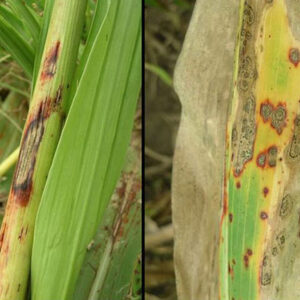
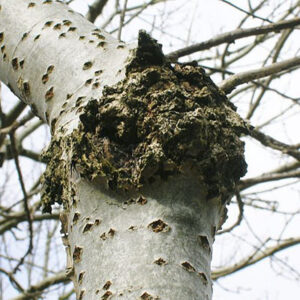
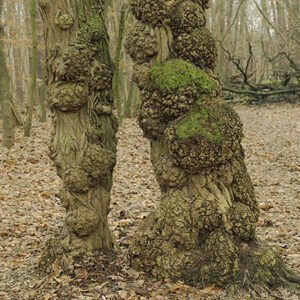
Photchana Trakunsukharat, Department of Agriculture, Thailand, CC BY 3.0 AU , via Wikimedia Commons
Bacterial leaf scorch (B)
- Causes: Bacterial leaf scorch is caused by the bacterium Xylella fastidiosa, which is transmitted by insect vectors such as sharpshooter and spittlebug. The bacterium colonizes the xylem tissue of the plant, blocking the flow of water and causing leaf scorch.
- Hosts: Bacterial leaf scorch affects a wide range of trees, including oak, maple, sycamore, elm, and sweetgum, among others. It can also affect shrubs and vines such as grape and blueberry.
- Symptoms: Symptoms include browning and necrosis of leaf margins, which may progress inward and lead to premature defoliation. Infected trees may also exhibit stunted growth, twig dieback, and eventual death.
- Management: Management involves reducing the risk of infection by controlling insect vectors, such as through insecticide treatments, removing infected plant material, and avoiding stress on trees, such as through proper irrigation and fertilization. There is currently no cure for bacterial leaf scorch, so prevention and early detection are key to reducing its impact.
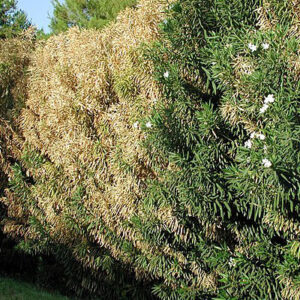
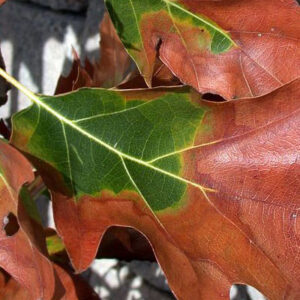
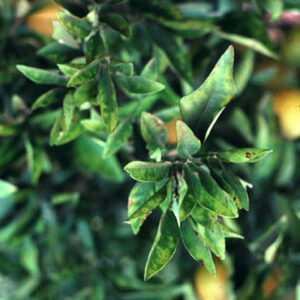
Alexander Purcell, University of California, Bugwood.org -, CC BY 3.0 , via Wikimedia Commons
Black knot (F)
- Causes: Black knot is caused by the fungus Apiosporina morbosa, which infects the tree through wounds or natural openings and causes abnormal growth of the bark and underlying tissues.
- Hosts: Black knot primarily affects trees in the Prunus genus, including plum, cherry, and related species.
- Symptoms: Symptoms include the formation of black, warty growths or knots on the branches and stems of the tree. These growths may vary in size and can cause the affected branch or stem to die back. In severe cases, the disease can cause significant damage or even kill the entire tree.
- Management: Management of black knot involves removing and destroying infected plant material, including the knots and surrounding branches, and maintaining good plant health through proper watering, fertilization, and pruning practices. Fungicide treatments may also be effective in preventing new infections or reducing the severity of existing ones, but should be applied preventatively or at the first sign of symptoms.
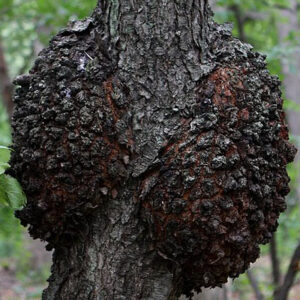
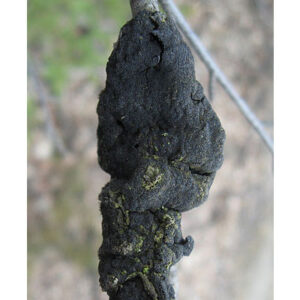
Sasata, CC BY-SA 3.0 , via Wikimedia Commons
Botrytis (gray mold) (F)
- Causes: Botrytis is caused by various species of fungi that can survive on plant debris or infected plant tissues. The fungi can spread through wind, rain, and contaminated equipment or tools. Botrytis can also infect wounded or stressed plants.
- Hosts: Botrytis can infect many plants, including flowers, fruits, vegetables, and ornamental plants. Some of the most common hosts include strawberries, grapes, tomatoes, lettuce, and roses.
- Symptoms: Botrytis typically appears as a gray or brown fuzzy mold on infected plant tissues, such as leaves, stems, flowers, or fruits. The mold can quickly spread and cause the tissues to rot, wither, or become mushy. In some cases, the mold can produce small black structures called sclerotia, which can survive in soil and infect future plants.
- Management: The best way to manage Botrytis is through a combination of cultural and chemical controls. Cultural controls include removing infected plant debris, practicing good sanitation, and avoiding overhead irrigation. Chemical controls include the use of fungicides, which should be applied at the right time during the growing season.

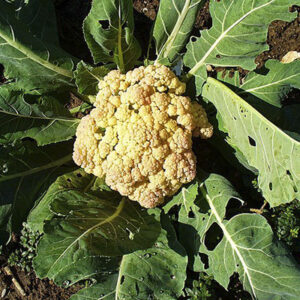
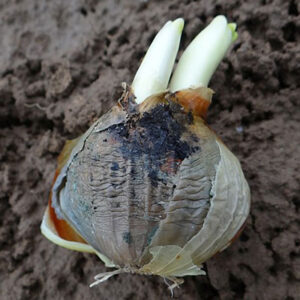
Ninjatacoshell, CC BY-SA 3.0 , via Wikimedia Commons
Boxwood blight (F)
- Causes: Boxwood blight is caused by the fungus Calonectria pseudonaviculata (formerly known as Cylindrocladium buxicola), which can infect trees through spores that can be spread by wind, water, animals, or contaminated equipment.
- Hosts: Boxwood blight primarily affects boxwood shrubs (Buxus species), but can also infect other plants in the same family, such as sweet box (Sarcococca) and pachysandra.
- Symptoms: Boxwood blight symptoms include brown or black leaf spots, defoliation, and stem cankers. Infected leaves may have a fuzzy appearance due to the production of spores on the leaf undersides. In severe cases, the disease can cause rapid defoliation and dieback of the plant.
- Management: Management of boxwood blight involves removing and destroying infected plant material, avoiding overhead irrigation, and maintaining good air circulation and drainage around the plants. Fungicide treatments may also be effective for preventing infection of new growth, but should be applied preventatively or at the first sign of symptoms – there are no fungicides that will kill the fungus after infection. Additionally, practicing sanitation measures, such as disinfecting tools and equipment between uses and avoiding movement of infected plant material, can help reduce the spread of the disease.
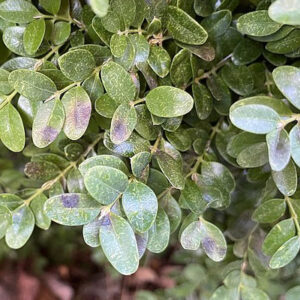
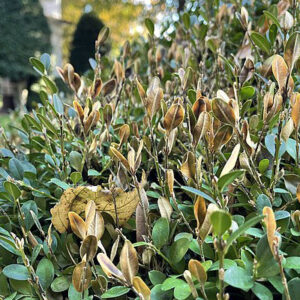
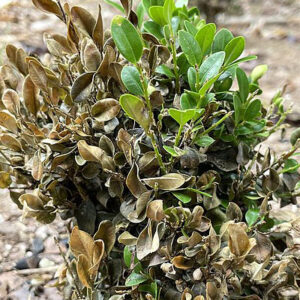
m.borden, CC BY-SA 2.0 , via Wikimedia Commons
Bur oak blight (F)
- Causes: Bur oak blight is caused by a fungus known as Tubakia iowensis. The fungus can survive in infected leaves and bark, and can spread to other parts of the tree through wind, rain, or contaminated tools or equipment.
- Hosts: Bur oak blight primarily affects bur oak trees (Quercus macrocarpa), which are native to North America.
- Symptoms: Bur oak blight symptoms include brown, irregularly shaped lesions on the leaves, which can cause the leaves to wilt or drop prematurely. In severe cases, the disease can defoliate the tree and cause dieback of twigs and branches.
- Management: There is no cure for bur oak blight, so management focuses on preventing the spread of the disease. This includes removing and destroying infected leaves and debris, pruning infected branches, and avoiding overhead irrigation. Fungicide treatments can also be used to protect new leaves from infection, but they should be applied preventatively or at the first sign of symptoms.
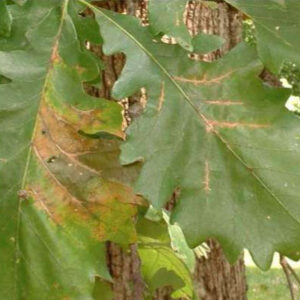
Cankers (F, B)
- Causes: Cankers can be caused by various factors, including fungal and bacterial infections, insect damage, and environmental stresses such as drought, frost, or sunscald. The initial cause weakens the bark, making it more susceptible to other pathogens.
- Hosts: Cankers can affect a wide range of trees and woody plants, including fruit trees, ornamentals, and forest trees. Some of the most susceptible species include dogwood, oak, pine, and maple.
- Symptoms: Canker symptoms vary depending on the host and the severity of the infection, but can include sunken or swollen areas of bark, discolored or dead tissue, oozing sap, and wilting or dieback of branches. In severe cases, the disease can kill the entire plant.
- Management: Management of cankers depends on the cause and severity of the infection. This can include removing and destroying infected plant material, pruning infected branches, and improving tree health through proper watering, fertilization, and mulching. Fungicide or antibiotic treatments may also be effective for some bacterial and fungal canker diseases, but are most effective when used preventatively. Additionally, avoiding mechanical damage, providing proper drainage, and maintaining good tree hygiene can help reduce the risk of canker infections.
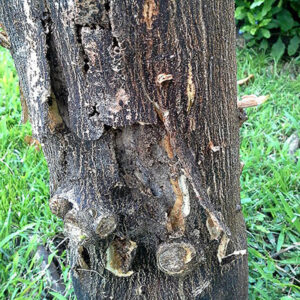
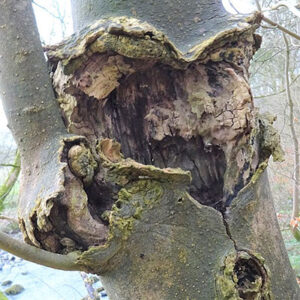
Scot Nelson from Honolulu, Hawaii, USA, CC0, via Wikimedia Commons
Collar rot (F)
- Causes: Collar rot is caused by soil-borne fungi such as Rhizoctonia, Fusarium, and Phytophthora. These fungi infect the base of the stem near the soil line, leading to decay and eventual death of the plant.
- Hosts: Collar rot can affect a wide range of plants, including vegetables, fruits, ornamentals, and trees.
- Symptoms: Symptoms of collar rot include wilting, yellowing of leaves, stunted growth, and root rot. The base of the stem may also appear discolored, and the plant may eventually die.
- Management: Prevention is key in managing collar rot, and steps such as proper irrigation, soil drainage can help reduce the risk of infection. Poor growing conditions is a leading cause – excess water is usually never good for plants especially where soil drainage is poor. Fungicides can also be used to control the disease, and infected plants should be promptly removed and destroyed to prevent the spread of the fungi.
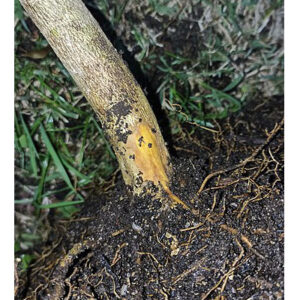
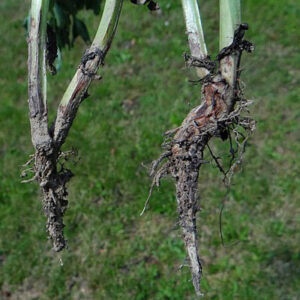
Eiku, CC BY-SA 4.0 , via Wikimedia Commons
Crown gall (B)
- Causes: Crown gall is caused by the bacterium Agrobacterium tumefaciens, which can enter the plant through wounds or natural openings and cause abnormal cell growth and the formation of tumor-like growths on the plant.
- Hosts: Crown gall can affect a wide range of plants, including trees, shrubs, vines, and herbaceous plants. In Illinois, commonly affected plants include; rose, maple, willow, euonymus, and raspberry.
- Symptoms: Crown gall symptoms include the formation of raised, irregularly shaped growths or galls on the roots, stems, and branches of the plant. These growths may vary in size and can interfere with the plant’s ability to transport water and nutrients, leading to stunted growth, yellowing, and wilting of leaves. In severe cases, the disease can cause plant death.
- Management: Management of crown gall involves removing and destroying infected plant material, avoiding mechanical damage to plants, and maintaining good plant health through proper watering, fertilization, and pruning practices. Chemical treatments may also be effective in preventing new infections, but should be applied preventatively or at the first sign of symptoms. Additionally, planting resistant cultivars and practicing crop rotation can help reduce the risk of crown gall infections.
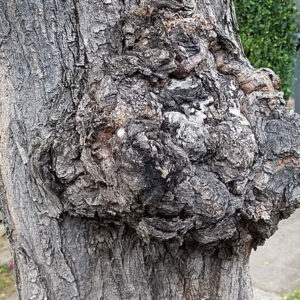
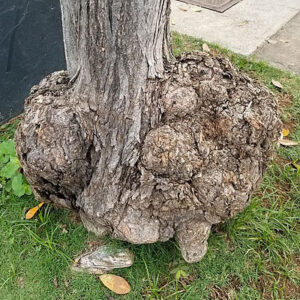
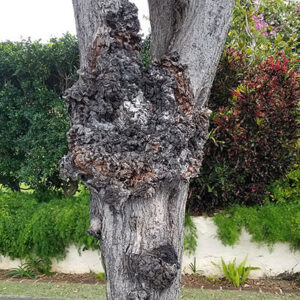
Scot Nelson, CC0, via Wikimedia Commons
Cytospora canker (F)
- Causes: Cytospora canker is caused by the fungus Leucostoma kunzei (formerly known as Cytospora kunzei), which can infect trees through wounds, pruning cuts, or natural openings. Stress factors such as drought, excessive moisture, or winter injury can increase the tree’s susceptibility to infection.
- Hosts: Affects various conifer species, including spruce, pine, and fir. It is most common in areas with cold, dry winters and warm, humid summers.
- Symptoms: Symptoms include sunken cankers on the bark, resin oozing from the cankers, and dieback of the branches and needles. The disease can also cause yellowing or browning of the needles, premature needle drop, and thinning of the tree canopy. In severe cases, the disease can lead to tree death.
- Management: Management of Cytospora canker involves removing and destroying infected plant material, pruning infected branches, and improving tree health through proper watering, fertilization, and mulching. Avoiding mechanical injuries to the tree, such as from lawn mowers or weed whips, can also reduce the risk of infection. Fungicide treatments may be effective for preventing infection of new growth, but should be applied preventatively or at the first sign of symptoms.

Diplodia blight (F)
- Causes: Diplodia blight is caused by the fungus Diplodia pinea, which can survive on infected plant material and spread through wind, rain, or contaminated tools or equipment.
- Hosts: Primarily affects conifer species such as pine, spruce, and fir, but can also affect other trees and woody plants. It is most common in areas with warm, humid climates and high levels of precipitation.
- Symptoms: Symptoms include brown or grayish needles, stunted shoots, and premature needle drop. The disease can also cause cone blight and cankers on the stems and branches. In severe cases, the disease can lead to tree death.
- Management: Management of Diplodia blight involves removing and destroying infected plant material, pruning infected branches, and improving tree health through proper watering, fertilization, and mulching. Fungicide treatments may also be effective for preventing infection of new growth, but should be applied preventatively or at the first sign of symptoms.
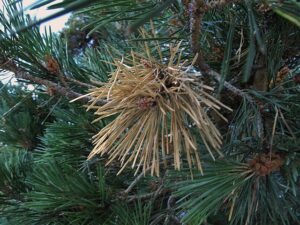
jacilluch, CC BY-SA 2.0 , via Wikimedia Commons
Downy mildew (F)
- Causes: Downy mildew is caused by various species of fungi that can survive in the soil, infected plant debris, or as spores in the air. The fungi can infect the plant when there is high humidity or moisture, especially in cool weather conditions.
- Hosts: Can infect many plants, including vegetables, fruits, ornamental plants, and weeds. Some of the most common hosts include cucumbers, grapes, lettuce, roses, and impatiens.
- Symptoms: Symptoms vary depending on the host plant, but can include yellow or pale green spots on the leaves, followed by a fuzzy gray or purple growth on the undersides of the leaves. The leaves may also curl, wilt, or drop prematurely. In severe cases, the plant may die.
- Management: The best way to manage downy mildew is through a combination of cultural and chemical controls. Cultural controls include avoiding overhead irrigation, practicing good sanitation, and removing infected plant debris. Chemical controls include the use of fungicides, which should be applied preventatively or at the first sign of symptoms. Preventive measures, such as using resistant cultivars, maintaining good plant health, and improving air circulation, can also help reduce the risk of downy mildew infections.
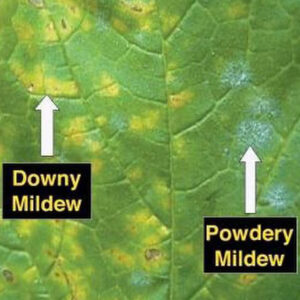
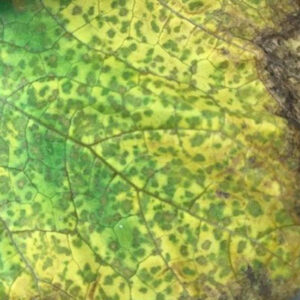
The original uploader was Agne27 at English Wikipedia.(Original text: David B. Langston, University of Georgia, United States), Public domain, via Wikimedia Commons
Dutch elm disease (F)
- Causes: Dutch elm disease is caused by the fungus Ophiostoma ulmi or Ophiostoma novo-ulmi, which is spread by elm bark beetles that carry spores from infected trees to healthy ones.
- Hosts: Some species are more susceptible than others. American elm and Siberian elm are highly susceptible, while some cultivars of European elm may have some resistance.
- Symptoms: Symptoms include wilting and yellowing of leaves, typically starting at the top of the tree and progressing downward. Leaves may also curl and turn brown or fall off prematurely. Infected trees may develop brown streaks or patches in the sapwood and outer bark, and may die within a few years of infection.
- Management: Management of Dutch elm disease involves removing and disposing of infected trees, as well as preventing the spread of the disease by controlling elm bark beetle populations through insecticides, removing infested branches, and pruning elm trees during the dormant season. Fungicide injections may also be effective in treating individual trees, but must be applied by a certified arborist. Additionally, planting resistant cultivars or diverse tree species in areas with Dutch elm disease can help prevent the disease from spreading.
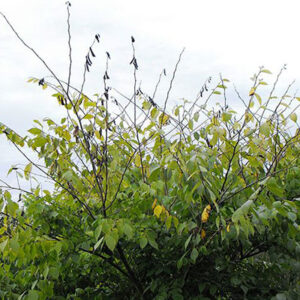
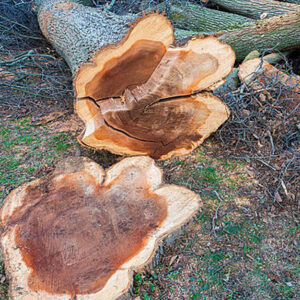
Ptelea (talk) 10:49, 21 July 2009 (UTC), Public domain, via Wikimedia Commons
Fireblight (B)
- Causes: Fire blight is caused by the bacterium Erwinia amylovora, which can infect trees through natural openings or wounds, such as from pruning or hail damage. The bacterium can also spread through insect vectors or contaminated tools or equipment.
- Hosts: Affects various members of the rose family, including apple, pear, quince, and crabapple. It is most common in areas with warm, humid weather and high rainfall.
- Symptoms: Symptoms include wilting and blackening of the blossoms, shoots, and leaves, giving them a scorched appearance. The disease can also cause cankers on the branches and trunk, which can lead to dieback of the affected area. In severe cases, the disease can lead to tree death.
- Management: Management of fire blight involves removing and destroying infected plant material, pruning infected branches, and improving tree health through proper watering, fertilization, and mulching. Fungicide treatments may also be effective for preventing infection of new growth, but should be applied preventatively or at the first sign of symptoms.
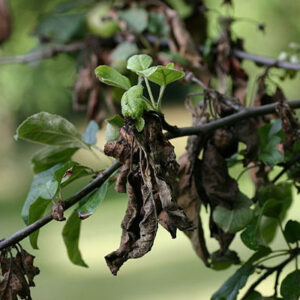
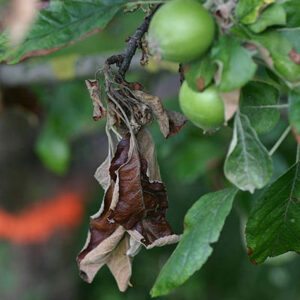
I, Paethon, CC BY-SA 3.0 , via Wikimedia Commons
Leaf spots and blights (F, B)
- Causes: Leaf spots and blights are caused by various species of fungi (and some bacteria) that can survive in soil, plant debris, or infected plant tissues. The fungi can spread through wind, rain, and contaminated equipment or tools.
- Hosts: Can infect a wide range of plants, including trees, shrubs, flowers, and vegetables. Some of the most common hosts include tomatoes, peppers, roses, dogwoods, and lilacs.
- Symptoms: Typically appear as circular or irregularly shaped lesions on the leaves, stems, and sometimes fruits of infected plants. The lesions can be various colors, including brown, black, or gray, and can be accompanied by yellowing or browning of the surrounding tissue. In severe cases, the leaves can become distorted, dry out, and fall off the plant.
- Management: The best way to manage leaf spots and blights is through a combination of cultural and chemical controls. Cultural controls include removing infected plant debris, practicing crop rotation, and avoiding overhead irrigation. Chemical controls include the use of fungicides, which should be applied at the right time during the growing season.
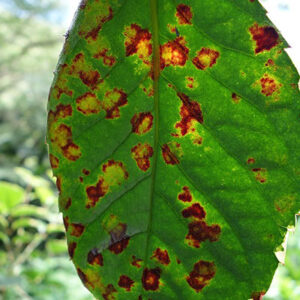
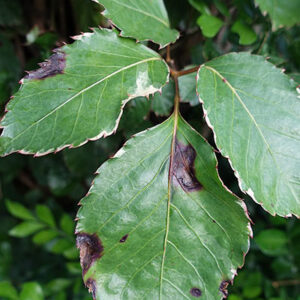
Scot Nelson, CC0, via Wikimedia Commons
Needle blights and casts (F)
- Causes: Needle blights and casts are caused by various species of fungi that can survive on infected needles, cones, or bark, and can spread through wind, rain, or contaminated tools or equipment. The fungi can enter the tree through wounds or natural openings, such as stomata.
- Hosts: Needle blights and casts can infect many conifer species, including pines, spruces, firs, and cedars.
- Symptoms: Needle blights and casts typically appear as brown or black lesions or spots on infected needles. The needles may also turn yellow or brown, and in severe cases, can fall off the tree prematurely, leading to reduced tree vigor and growth. In some cases, the fungi can also infect the bark, causing cankers or resinous ooze.
- Management: The best way to manage needle blights and casts is through a combination of cultural and chemical controls. Cultural controls include removing infected branches or trees, avoiding excessive fertilization or irrigation, and maintaining good tree health. Chemical controls include the use of fungicides, which should be applied at the right time during the growing season. Preventive measures such as planting resistant species and maintaining good tree hygiene can also help reduce the risk of infections.
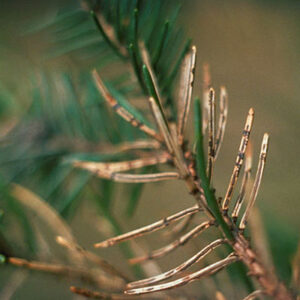
Minnesota Department of Natural Resources Archive, CC BY-SA 3.0 , via Wikimedia Commons
Oak wilt (F)
- Causes: Oak wilt is caused by the fungus Ceratocystis fagacearum, which spreads through interconnected root systems or through sap-feeding beetles that carry spores from infected trees to healthy ones.
- Hosts: Oak wilt primarily affects oak trees, with some species more susceptible than others. Red oaks, such as black oak and pin oak, are particularly vulnerable and may die within a few weeks of infection, while white oaks may take several years to succumb.
- Symptoms: Oak wilt symptoms include wilting and browning of leaves, typically starting at the top of the tree and progressing downward. Leaves may also show veinal necrosis, or brown or yellow discoloration between the leaf veins. Bark may crack or peel off, and fungal mats may develop under the bark or on the roots. Infected trees may die within a few months to several years, depending on the species and extent of the infection.
- Management: Management of oak wilt involves preventing the spread of the disease by avoiding pruning or wounding oak trees during the growing season, when sap-feeding beetles are active, and by trenching around infected trees to break the root connections. Fungicide injections may also be effective in treating individual trees, but must be applied by a certified arborist. Additionally, planting resistant cultivars or diverse tree species in areas with oak wilt can help prevent the disease from spreading.

Joseph O’Brien, USDA Forest Service, Bugwood.org, CC BY 3.0 via Wikimedia Commons
Phomopsis tip blight (F)
- Causes: Phomopsis tip blight is caused by the fungus Phomopsis spp., which can survive on infected plant material and spread through wind, rain, or contaminated tools or equipment. It can also overwinter in needles or small branches.
- Hosts: Phomopsis tip blight can affect various conifer species, including pine, spruce, and juniper. It is most common in areas with warm, humid climates and high levels of precipitation.
- Symptoms: Phomopsis tip blight symptoms include brown or blackened needles, stunted shoots, and dieback of the tips and twigs. The disease can also cause cankers on the stems and branches. In severe cases, the disease can lead to tree death.
- Management: Management of Phomopsis tip blight involves removing and destroying infected plant material, pruning infected branches, and improving tree health through proper watering, fertilization, and mulching. Fungicide treatments may also be effective for preventing infection of new growth, but should be applied preventatively or at the first sign of symptoms.
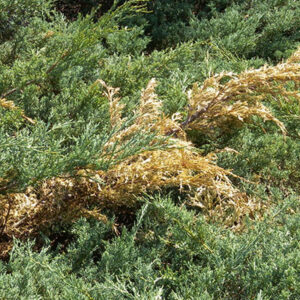
Pine wilt (N)
- Causes: Pine wilt is caused by the pine wood nematode, Bursaphelenchus xylophilus, which is transmitted by the pine sawyer beetle. The nematode feeds on the resin canals of the tree, disrupting the flow of water and causing the tree to wilt and die.
- Hosts: Pine wilt primarily affects various species of pine trees, including Japanese black pine, Scots pine, and Austrian pine, among others. It is most prevalent in Asia, but has also been found in Europe and North America. White pine however, is rarely affected.
- Symptoms: Symptoms include rapid wilting and browning of needles, starting at the top of the tree and progressing downward. Infected trees may also develop a reddish-brown discoloration in the sapwood, and may eventually die within a few months of infection.
- Management: Management involves preventing the spread of the disease by controlling pine sawyer beetle populations through insecticides and removing infected trees promptly. Preventive measures such as pruning trees during the dormant season, using disease-resistant cultivars, and avoiding stress on trees can also help reduce the likelihood of pine wilt infection. Once a tree is infected, there is no known cure, so early detection and removal of infected trees is crucial.
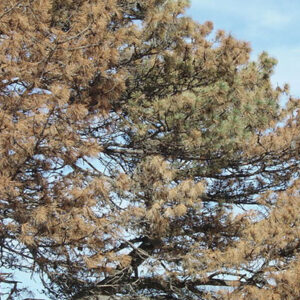
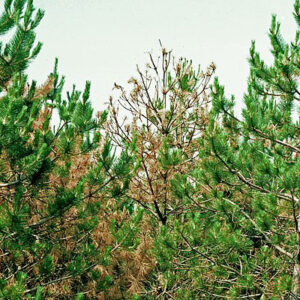
Mateinsixtynine at English Wikipedia, CC0, via Wikimedia Commons
Powdery mildew (F)
- Causes: Caused by a variety of fungal species in the Erysiphales order, which thrive in warm and humid conditions.
- Hosts: Infects a wide range of plants, including vegetables, fruits, ornamentals, and trees.
- Symptoms: Powdery mildew appears as a white or grayish powdery coating on the leaves, stems, and flowers of infected plants. It can also cause yellowing, distortion, and eventual death of plant tissue.
- Management: Can be managed through cultural practices such as regular watering, pruning, and proper plant spacing. Fungicides and biological controls can also be effective in controlling powdery mildew, but it is important to choose the appropriate method for the specific plant and fungal species involved.
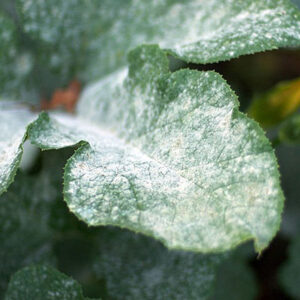
Jeff Kubina, Public domain, via Wikimedia Commons
Root Rots (F)
- Causes: The main fungi causing root rot are Rhizoctonia, Fusarium, Pythium, and Phytophthora.
- Hosts: Vegetables, annuals, perennials, all seedlings and small fruits.
- Symptoms: The symptoms are varied with the many causes. Generally, you will see weak and often dying plants that wilt and have little vigour. Sometimes the roots appear slimy and wet, or have a reddish brown color.
- Management: The importance of good drainage cannot be over-emphasized – it is a leading cause of root rot. If it is not because of drainage you can try a fungicide. Remove plants that cannot be saved.
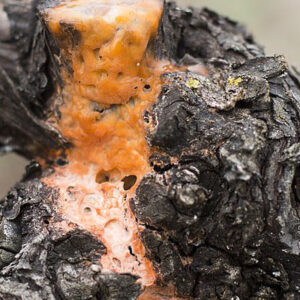
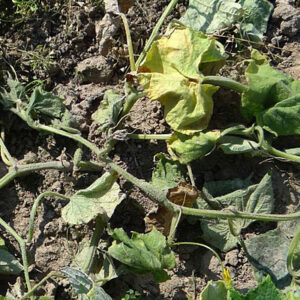
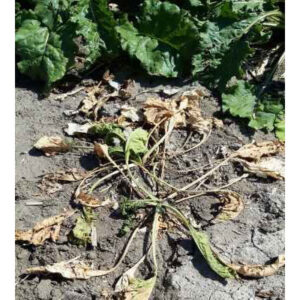
Rose mosaic (V)
- Causes: Rose mosaic is caused by various viruses, including Prunus necrotic ringspot virus and Apple mosaic virus, that can be transmitted by infected plant material or by insect vectors such as aphids. The viruses can survive in the plant’s vascular system and spread to other parts of the plant.
- Hosts: Rose mosaic can infect many species of roses, including hybrid teas, floribundas, and grandifloras.
- Symptoms: Rose mosaic symptoms vary depending on the virus and the severity of the infection, but can include yellow or green mosaic patterns on the leaves, distorted growth, reduced flower production, and stunted growth. In severe cases, the plant may die.
- Management: There is no cure for rose mosaic, so management focuses on preventing the spread of the virus. This includes removing and destroying infected plant material, avoiding the use of contaminated tools or equipment, and controlling aphid populations.
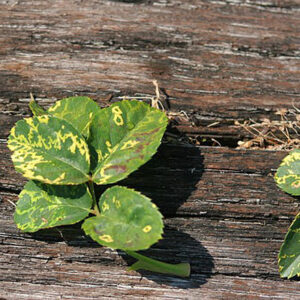
Malcolm Manners from Lakeland FL, USA, CC BY 2.0 , via Wikimedia Commons
Rust (F)
- Causes: Rust is caused by various species of fungi that typically require moisture to grow and spread. These fungi can survive on living or dead plant material and can be spread by wind, water, and insects.
- Hosts: Can infect a wide range of plants, including trees, shrubs, flowers, and vegetables. Some of the most common hosts include roses, hollyhocks, beans, wheat, and corn.
- Symptoms: Rust is characterized by the appearance of small, yellow-orange to brownish-red pustules on the leaves, stems, and sometimes flowers or fruit of infected plants. As the disease progresses, these pustules can merge, forming larger patches that can cause leaf and stem distortion, premature leaf drop, and decreased plant vigor.
- Management: The best way to manage rust is through a combination of cultural and chemical controls. Cultural controls include removing infected plant material, providing adequate spacing between plants, and promoting good air circulation. Chemical controls include the use of fungicides, which should be applied early in the season to prevent infection or immediately upon the first signs of infection.
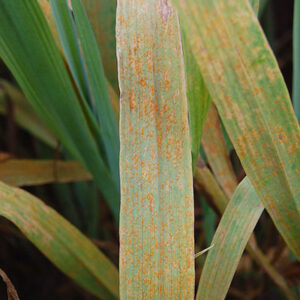
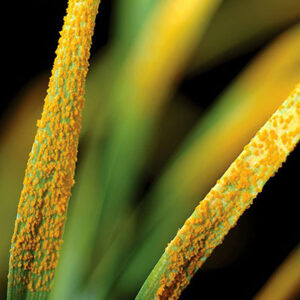
Lucyin, CC BY-SA 4.0 , via Wikimedia Commons
Scab (F)
- Causes: Caused by various species of fungi that can survive in soil, plant debris, or infected plant tissues. The fungus spreads through wind, rain, and contaminated equipment or tools.
- Hosts: Scab can infect many plants, including fruits, vegetables, and ornamental plants. Some of the most common hosts include apples, pears, potatoes, peaches, and roses.
- Symptoms: Typically appears as small, circular, raised lesions on the leaves, fruits, and stems of infected plants. These lesions can be various colors, including dark brown, black, or olive-green. As the disease progresses, the lesions can merge, causing scabby or corky areas on the plant, which can affect the plant’s growth and yield.
- Management: The best way to manage scab is through a combination of cultural and chemical controls. Cultural controls include removing infected plant debris, practicing crop rotation, and avoiding overhead irrigation. Chemical controls include the use of fungicides, which should be applied at the right time during the growing season. Preventive measures such as resistant cultivars and maintaining good plant health can also help reduce the risk of scab infections.
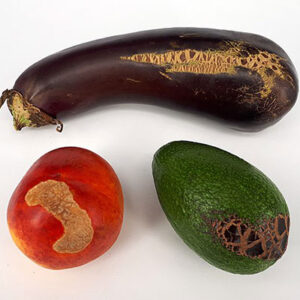
Fructibus, CC0, via Wikimedia Commons
Sooty mold (F)
- Causes: Grows as a result of an infestation of sap-sucking insects like aphids, whiteflies, and mealybugs. These insects excrete a sugary substance called honeydew that serves as a food source for the fungus.
- Hosts: Can grow on a wide range of plant species, including trees, shrubs, and ornamental plants. Some of the most common hosts include citrus trees, hibiscus, gardenia, and camellia.
- Symptoms: The main symptom of sooty mold is the black, velvety coating that covers the surface of leaves, stems, and other plant parts. This coating can interfere with photosynthesis, leading to stunted growth, yellowing leaves, and a decline in plant health.
- Management: The best way to manage sooty mold is to control the underlying insect infestation. This can be done through a combination of cultural practices (like pruning and fertilizing), biological controls (like ladybugs and lacewings), and chemical controls (like insecticidal soap and neem oil). Once the insect population is under control, the sooty mold can be washed off the plant surfaces using a mild soap and water solution.
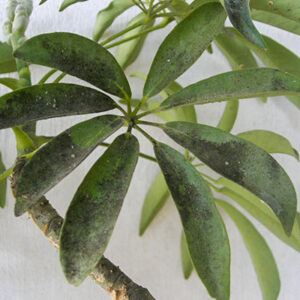
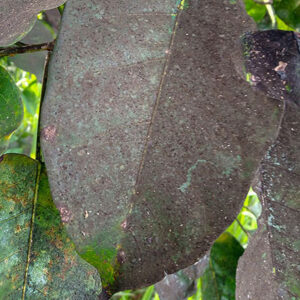
Image: Amnon Shavit, CC BY-SA 3.0 , via Wikimedia Commons
Verticillium wilt (F)
- Causes: Verticillium wilt is caused by soil-borne fungi of the Verticillium genus, which infect the plant through the roots and spread through the vascular system, causing wilting and dieback of leaves and branches.
- Hosts: Verticillium wilt affects a wide range of plants, including trees, shrubs, and herbaceous perennials, with different strains of the fungus infecting different hosts. In Illinois, this fungus often affects maples, redbud, smoketree, ash and magnolia.
- Symptoms: Verticillium wilt symptoms include wilting and yellowing of leaves, often starting at the lower branches and progressing upward, as well as dieback of branches and stunted growth. The vascular system of the plant may also show discoloration or browning, and leaves may drop prematurely. In some cases, the entire plant may die.
- Management: Management of verticillium wilt involves preventing the introduction of the fungus into the soil, as well as removing and destroying infected plant material. Fungicide treatments may also be effective in reducing the spread of the disease, but are not usually recommended as a primary control method. Additionally, maintaining good plant health through proper watering, fertilization, and pruning practices can help reduce the risk of infection. Crop rotation, soil sterilization, and planting resistant cultivars can also help prevent the spread.

